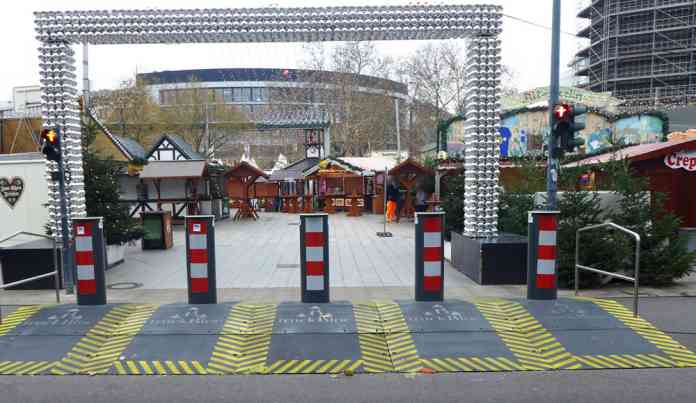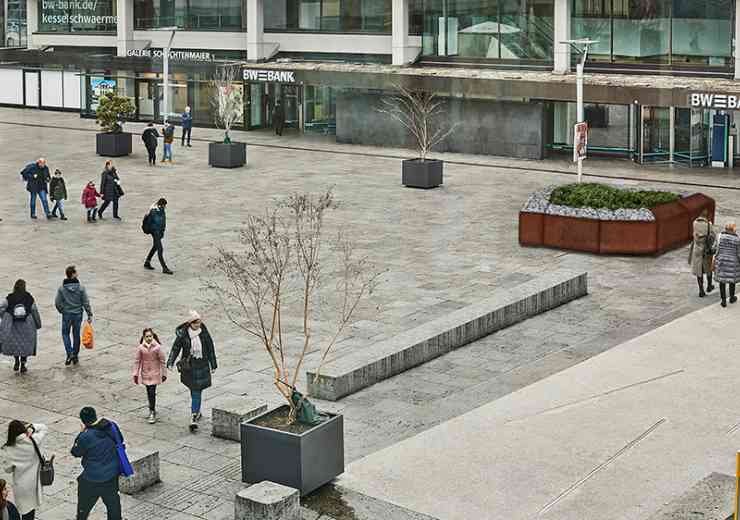
Temporary HVM of Christmas markets and outdoor events
On 19 December 2016, the worst attack ever recorded on a Christmas market took place at Breitscheidplatz in Berlin, a very popular venue in the centre of the German capital. Since then, Christmas market and outdoor event operators have been applying advanced physical security measures in order to protect their events from hostile vehicles.
In this article, Christian Schneider, a Germany-based Hostile Vehicle Mitigation Advisor who became responsible for the HVM measures at the Breitscheidplatz in 2018 discusses applied Hostile Vehicle Mitigation, lessons learned and best practices.
As extremists increasingly use hostile vehicle tactics to perpetrate attacks on publicly accessible locations (PALs), we are confronted with new security challenges that underline our need to improve the protection of these public spaces. Christmas markets and other outdoor events are a particularly vulnerable type of soft target embodying those challenges. A key aspect in the evolution of hostile vehicle tactics is the transition from the use of vehicles as weapon carriers to using the vehicle itself as the weapon.
Vehicle attacks
This is hardly surprising, as various terrorist organisations have been calling on their followers to use vehicles as effective weapons since 2010 (“The ultimate mowing machine”, INSPIRE (2010)). For among the many means of attack, vehicles may be considered as a kind of a disruptive technology and thus offer extremists a multitude of extraordinary advantages (“Truck Attacks “, Rumiyah (2017)). The increased use of this tactic is confirmed by statistics, which demonstrate a significant increase in vehicle as weapon attacks since 2014. This phenomenon affects all communities equally, regardless of whether they are large cities, small towns or villages. Whilst vehicle-as-a-weapon attacks, such as those in London, Nice, Barcelona and Berlin are well known in the public domain, lesser-known European towns like Volkmarsen (Germany), Strépy-Braquegnies (Belgium) or Marbella (Spain) have also made headlines as a result of ramming-attacks. Or were you aware of those towns’ existence prior to the attacks?
In addition to vehicle ramming attacks, we must also contend with accidents that occur in PALs, as was the case in August 2022, when a heavy lorry accidentally crashed into a street party near Rotterdam (The Netherlands), with fatal consequences.
Protection
Hence, protecting PALs from accidents and vehicle-ramming attacks is increasingly important. Fortunately, the protection mechanisms required to meet these challenges are already well-known best practise.
If we take a closer look at physical protection against hostile vehicles, it quickly becomes obvious that the reliability of any measure is inextricably linked to the quality and care of its prior planning. True to the motto “He who fails to plan is planning to fail” (Sir Winston Churchill (1874 – 1965)), good planning is the key to sustainable success. Seriousness, competence, experience and impartiality are the essential requirements for the planners of any security and protection measure. Of course, serious planning includes the elaboration of a threat, vulnerability and risk assessment, comprehensive operational requirements (ORs), as well as adherence to the relevant guidance standards but also requires an effective planning process. Here, the RIBA Plan of Work has long proven to be a particularly helpful guidance for effective planning. And this holds true for both, permanent AND temporary measures. Following RIBA’s Plan of Work not only enhances the planning process with a clear and effective structure, but also supports the project manager and all those involved in the project to do the right things in the most effective order, and timing. It also helps to resist the common “quick-fix” impulse to prematurely think of deploying certain types of VSBs before the planning process begins by first and foremost keeping focus on producing prerequisite operational requirements.
Process not product
The reason behind this simply is the fact that security is not a product, but the result of a process carried out prudently, that leads to comprehensive, well thought through, and proportional measures.
In general, there are three main concepts to apply physical protection measures: Installing permanent VSBs that require permanent foundations, deploying portable barriers that are usually surface placed, or a side-by-side combination of both. Naturally, each of these three methods has its particular advantages and disadvantages, and unfortunately there is no magic VSB that will always lead to the best result in every situation and certainly never will without a detailed analysis of the local conditions, needs and operational requirements. But again, the good news is that though there is no “one-size-fits-all” solution for all protective areas, the assessment and planning process described above, conducted in close collaboration with dedicated specialist security consultants will almost always lead to the most optimised solution, i.e. safe, secure, economic, aesthetic and practical.
However, more often than not, sites for Christmas markets and other open-air events need to be protected on a short notice, thus asking for the deployment of temporary protective measures, e.g. surface placed VSBs. Such portable measures are neither worse nor better than permanent measures, but they are fundamentally different in vehicle impact performance, and, most notably, vehicle penetration distance and debris dispersion. Thus, surface placed measures require particular design and application, because these types of barriers usually do not possess their own foundations, thus require a comprehensive knowledge of their engineering characteristics, surface needs and civils constraints, such as ground conditions, drainage, weight, deployability, recovery, etc. Hence, a deep understanding of their interaction with the surface of the installation is vital in order to predict the VSBs likely performance in case of an impact. That said, it is essential that only impact rated barriers are applied, i.e. VSBs that have been awarded with a matching performance rating of an internationally recognised crash-test standard (ISO 22343-1 (2023); ISO IWA 14-1 (2013); PAS 68 (2013))! Also bear in mind that a VSB is designed for a specific application and should only be deployed if its performance rating meets the requirements of the particular Vehicle Dynamic Assessment (VDA) carried out for the very site of deployment. This means that a VSB that was rated to stop a standard car at low speed is most unlikely to work against a lorry or worse, a heavy-duty vehicle.
While in the United Kingdom, thanks to the work of the security authorities over many years already, one sees impressively well thought-out security measures in place at many sites, elsewhere, however, there often still is a lot of room for improvement.
There are useless and highly dangerous block-out attempts around, that are not only doomed to fail but are even causing an increased level of latent and operational hazard to the crowd. This is why those who rush to think of HVM just being bollards, concrete blocks and alike quickly find themselves in a very dangerous dilemma, because premature measures compromise on people’s safety and security rather than improving them.
Therefore, by following good guidance, applying relevant standards correctly and using the services of suitably qualified and experienced HVM security consultants, the risks of deploying ineffective security solutions will be greatly reduced. Even the temporary protection of rarely used publicly accessible locations is nowadays quite easily achievable by qualified experts! Misapplications can usually be traced back to the widespread misconception that Hostile Vehicle Mitigation measures are simply a matter of erecting barriers.
In a nutshell, expertise and experience are key to achieving a reliable level of protection. There is no need to take the risk of trial and error, but seek advice from your local Police, CTSAs, and specialist HVM security consultants. Well trained support is just a mouse-click away.
HVM is not a product, but a joint best practice process of security, engineering planning, and architectural engagement, comprising of organisational, technical, and personnel measures.
Well considered Hostile Vehicle Mitigation provides a win-win situation for all the stakeholders involved. It results in providing reliable protection for temporary and permanent venues and sites, contributes to the visitor’s individual perception of safety and security, and thus is significantly increases the attractiveness and success of the events taking place there.
For all readers and interested decision-makers who would like to learn more about how to plan, design and implement reliable protection measures, I recommend browsing through the comprehensive and easy-to-understand guides offered by the NPSA and ProtectUK, which are available on the internet. Here you will not only find the important references to the standards and guidelines, but also a lot of best practise, good tips and most valuable and impartial advice.
About the author:
Christian Schneider has a strong background in engineering and mitigation of dynamic loads.
He founded the INIBSP “Initiative Breitscheidplatz” in 2017 after the terrible Vehicle Ram Attacks of Nice and Berlin, as a non-profit expert forum aiming to quickly provide relevant HVM know-how to decision makers in Germany.
Since then, his enterprise has developed into the leading consultancy on the topic in German-speaking countries. Together with international experts and local authorities, he developed and implemented numerous HVM schemes for the protection of entire city centres, airports, critical infrastructures, stadiums and public spaces. Schneider is member of HVM standards and norms committees, and author of multiple articles on the topic of HVM. His commitment and devotion to protecting people form hostile vehicles earned him the nickname “Poller-Pabst” (Bollard Pope) in Germany.
















